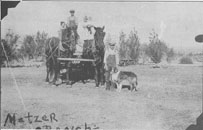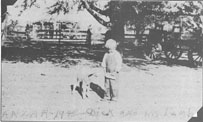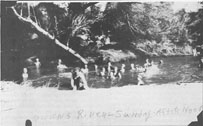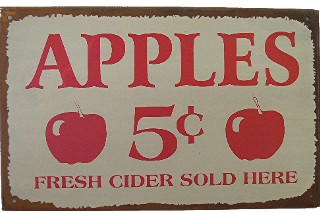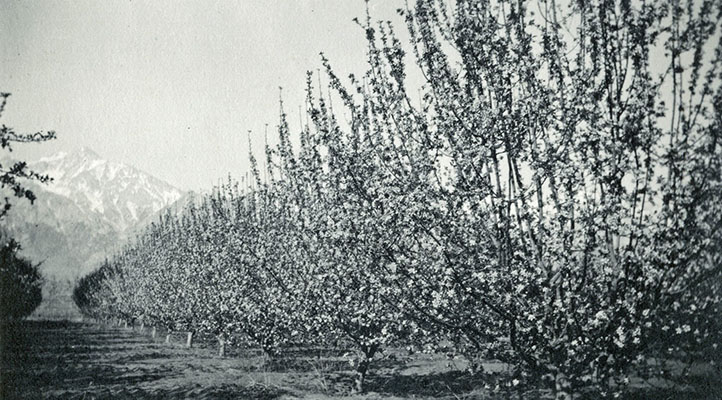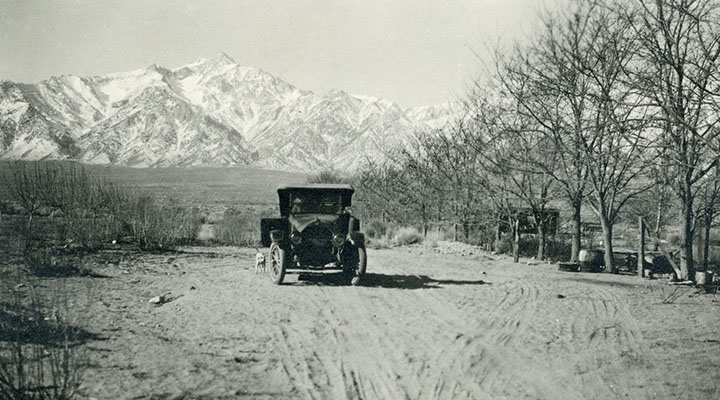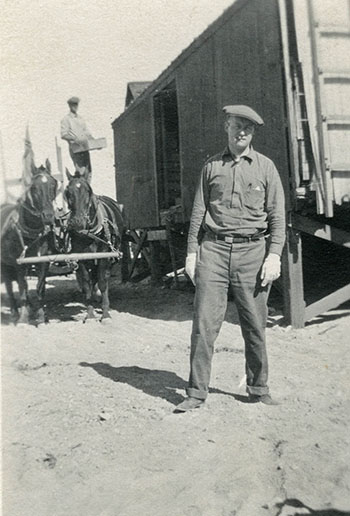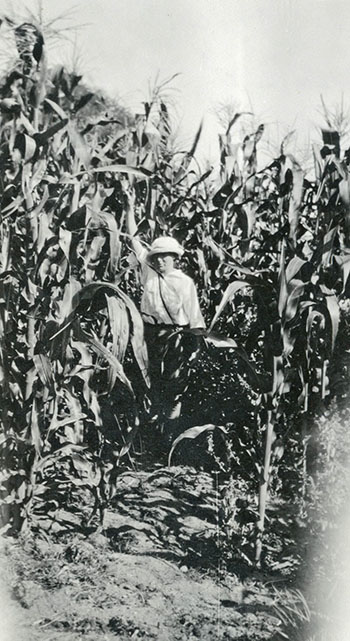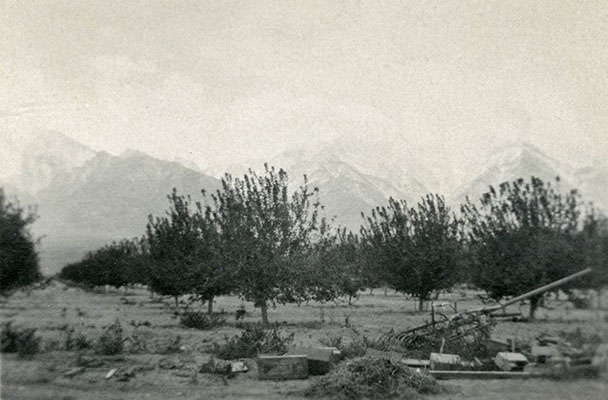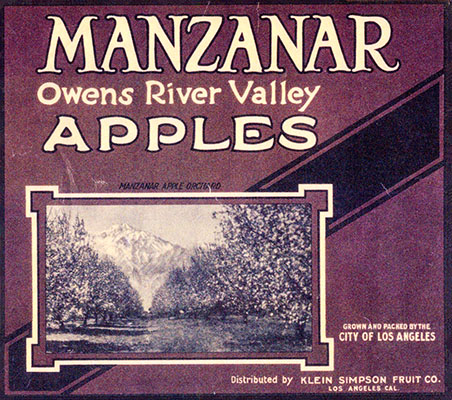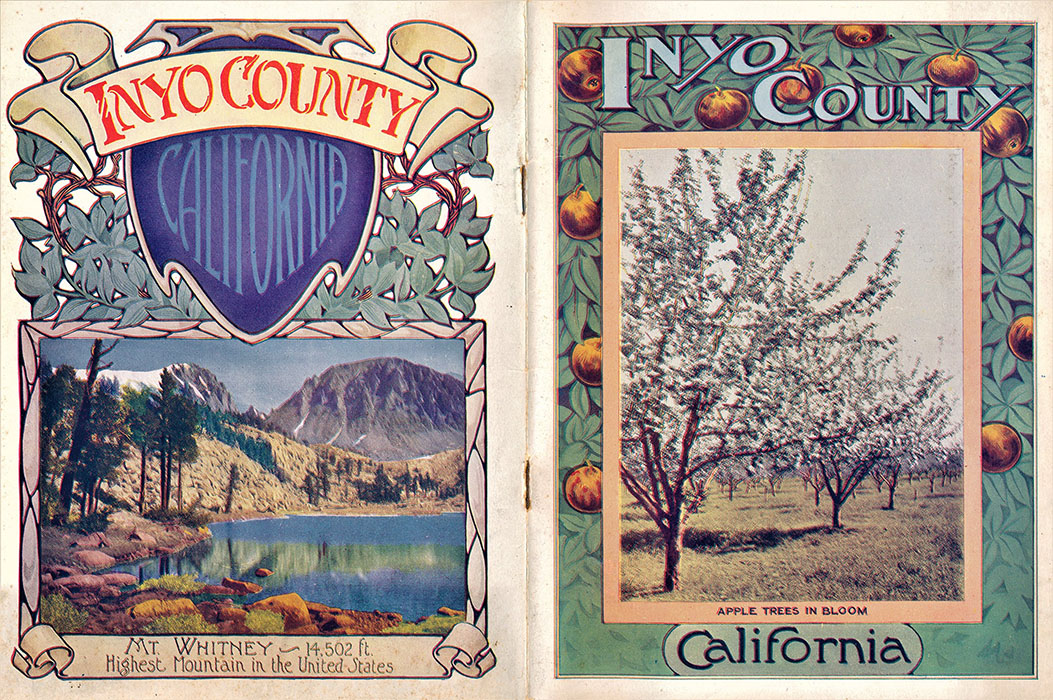|
Owens Valley's Land of Apples, Peaches, Pears |
|
"The Album: Times & Tales of Inyo-Mono" 1993 by Chalfant Press See USE NOTICE on Home Page. |
Manzanar: A Life Story
by Lucille DeBoer
Early Manzanar Town History
from the WWII War Relocation Authority Special History Study
When Manzanar was a new and blossoming town in Owens Valley.
Do You Remember Manzanar
by Katharine Krater
 NEW TRUNK LINE OPENS BIG VALLEY Owens River Country Now Becoming a Prosperous Apple and Farming District Los Angeles Times - May 3, 1912 |
BISHOP, May 3. - The Central Pacific railroad company or Harriman system recently absorbed a number of branch lines, among which was the Nevada-California, that extends from Hazen, Nev. on the Southern Pacific, south to Mojave in this state by way of Tonopah Junction and Munt Whitney in Owens river valley. Between Tonopah Junction and Mount Whitney station the road is still narrow guage but will shortly be broadgauged, completing a new transcontinental line over the Southern Pacific system from Los Angeles north to Hazen and east of the Sierra Nevada mountains and through Owens river valley. This new road will ultimately form part of a system extending from Los Angeles north to Portland by a shorter route than the present coast line division . This new division has been termed the "Orange Belt Route" and forms one of the shortest lines between Los Angeles and Chicago and will greatly facilitate the heavy citrus haul from southern California each year. The great benefit that the Owens river valley would derive from being on this new shortline transcontinental route can hardly be estimated. In this wonderful agricultural empire heretofore isolated and apart from the outside world, a complete change is taking place, from alfalfa and corn raising of a limited scale and cattle and sheep grazing as its chief industry. The Owens valley is being turned into one great apple orchard. It has been provend beyond a doubt that the big red export apple thrives here as in no place in the west; and apples and pears are destined to be the future chief products of this section. |
When Manzanar was a new and blossoming town in Owens Valley.
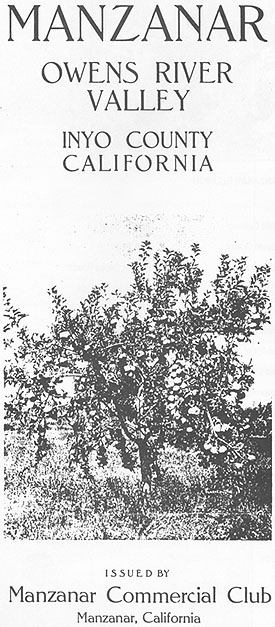
|
"This is one of the new towns in the Valley.... known as the 'Manzanar Irrigated Farms' tract, and consists of about 6,000 acres, subdivided into lots ranging from 16 to 25 acres each. "This tract is traversed by the main road through Owens River Valley. The bond issue carried in November, 1916, will provide funds for its immediate permanent improvement as an official State Highway. It will thus become one of the main arteries of the State of California... "Manzanar is about 245 miles from Los Angeles via rail, trains now leaving Los Angeles in the evening and reaching the Valley the following morning. As Pullman sleeper service is available, it makes for a very convenient and pleasant trip from Los Angeles... "There is no doubt that
sometime in the not distant future, transcontinental service
from Los Angeles to the east will be inaugurated through Owens
River Valley, as it will shorten the distance by about 100 miles
and make one of the greatest scenic roads in America...
"Owens Valley is on the route of the most attractive of all transcontinental automobile highways, the 'MIDLAND TRAIL.' The best natural route across Nevada comes into this Valley over Westgard Pass, in the White Mountains, a pass so rarely snow-blocked as to justify the assertion that it is always open. The traveler, reaching that summit, faces the grand panorama of the snow-covered Sierras, looming two miles higher than the green and gold checkered spread of the farms in the Valley at their foot... "Here is what Ex-Governor James N. Gillet says: 'I look for the day not far hence when Inyo will be the great attraction for tourists the world over.... an eager throng will hasten here to share with you the bounties that nature has so lavishly bestowed upon you."' |
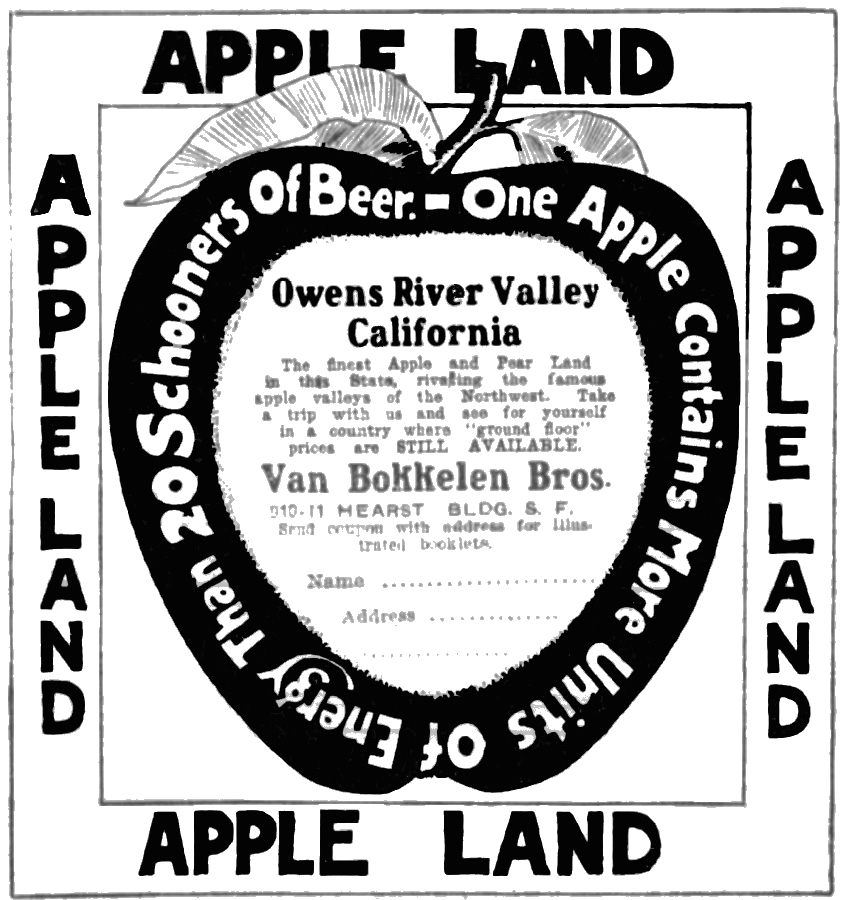
 INYO COUNTY IS LAND OF BIG CROPS AND SUNSHINE Oakland Tribune - 1912 |
Sunny California is famous for her contradictions. The truth told about her in the East and in foreign lands is often thought fable, and the stranger comes to marvel and to remain. Down in Inyo County there is the Owens River Valley,, which may be taken as a wonderful example of what is really the wizardry of this promised land. There is scarcely four inches of rain in the average year in this fertile region, and yet the farms are among the most prosperous on the Pacific Coast, and the percentage of profit is said to be larger per acre than anywhere else in the whole marvelous West. Set beyond the lofty Sierras in the eastern part of the state the Owens River Valley has been brought into sudden prominence by two commercially important facts. Two things have almost in a night called the attention of the cultivator of the soil to the remarkable possibilities of this section and sent the investor and the homeseeker on a hurried trip to get in on the ground floor. And these two contributing factors are transportation and irrigation. They are to bring about a wonderful transformation in the valley, and an era of tremendous prosperity is opening up for Bishop, the metropolis of the county, and all the country round. It is just these facts that contribute to make the prospects for speedy profit in this region better, now, it is represented, than in any other part of the country. "The Orange Belt Route" is the name the new railroad is know by, and it will enable the farmer to rush his products into a good market at a nominal expense. The railroad, however, is but one factor; there is the water. The snows on the summits of the Sierras have always furnished an abundant supply, which is more plentiful in the summer than in the winter, but attention has been called to the richness and wealth of the supply by the expenditure by the city of Los Angeles of $29,000,000 to secure this pure water for use in the southern metropolis. From the mountain fastnesses there flows the year roiund a rushing stream of sparkling water which irrigates the Owens River Valley, will supply the growing city of 400,000 people, and leave an almost inexhaustible quantity besides. This is the land of perpetual sunshine, where there are the fewest rainy days in the year, and where the climate is such that working is really a pleasure. Since the installation of transportation facilities thousands of acrews of grain and grazing land have been turned into fields of alfalfa and orchards of apple trees. The possibilities of this change may well be realized when it is known that the gravity watger system which can be used at an expense of only 15 cents per acre causes the land to produce from seven to ten tons of alfalfa. This brings $15 per ton in the Los Angeles market. The average temperature of Inyo County is 54.8 degrees, and this is sufficiently low to render the apple and pear trees dormant a few months each year, and makes these lands compete most favorably with the famed fruit farms of Colorado. The Owens River Valley bench land is reputed to be among the best in the world for the growing of apples and pears. The Tinemaha ranch in the valley was recently purchased by Mr. Frazier, a prosperous orange grower of Riverside and a well-known banker of that region, and the Klien Fruit Company of Los Angeles will handle the eitire output over the Southern Pacific Railroad. Van Borkelan Brothers have set 5000 acres to apple trees, and their example is being followed on a lesser scale by scores of others, with the result that this section bids fair soon to outrival the great apple producing communities of Oregon. A certain income is assured to the farmer by the raising of hogs and chickens and the growing of alfalfa, together with the planting of a goodly apple orchard. One farm of ninety-eight acres of alfalfa produced 700 tons of hay, which sold for $7000, and it is the boast of the residents that the farms yield from 10 to 20 percent on the investment. Nearly everything can be grown profitably in the Owens River Valley, and what is more, can be marketed cheaper, and with a greater margin of profit than in most other sections of the colossal West. |
Owens River Valley - Manzanar (Photos courtesy of Tales Along El Camino Sierra) |
|
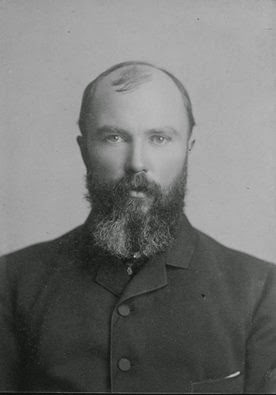 George Chaffey, brother of Southern California's Wiliam Chaffey, bought up thousands of acres of lands south of Independence in the Owens Valley in the early 1900s, with the intent of developing a huge agricultural community there. (Photo and text courtesy of Dave Woodruff) |
|
Vintage (1910) Magazine Cover Courtesy of Hal Eaton |
Photo courtesy of the California Transportation Library Digital Collection 1912 - Manzanar, CA, Pasear Tour |
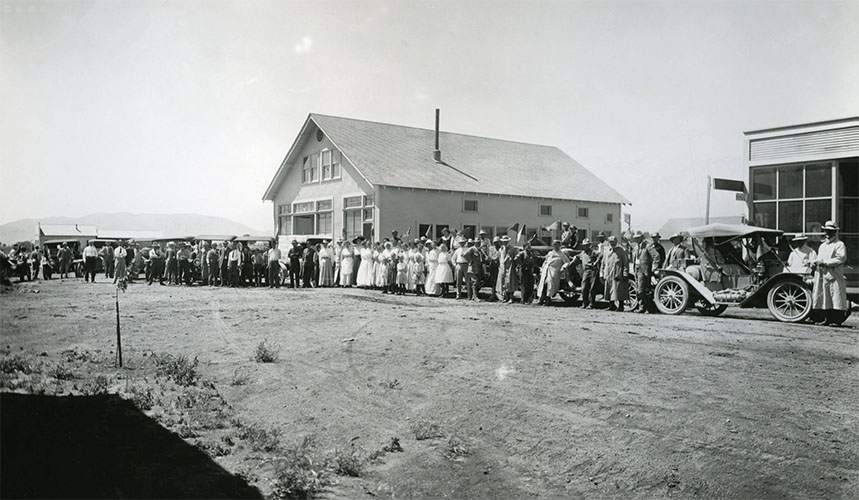 Manzanar - 1912 (Click here for a close-up of the group of people) "George Chaffey started the colony later known a Manzanar as the Owens Valley Improvement Company which can be seen on the window of the main building, so this is very likely Manzanar in 1912 with the local colonists serving lemonade. Includes blow-up of window." Hal Eaton “George Chaffey was a land developer, who along with his brother, William, founded communities in San Bernardino County like today’s Ontario and Upland (1886). Ontario is named after his homeland in Canada. Chaffey encountered William Mulholland, who needed to acquire property owned by Chaffey’s founded community of Manzanar (1905) that was in line with the proposed Los Angeles Owens Valley aqueduct. ( An account is found in Catherine Mulholland’s masterful “William Mulholland and the Rise of Los Angeles”, 2000.) The life’s and the works of two water engineers intersected, one from Canada and one from Ireland, in the Owens Valley, determining the fate of the Owens Valley." Paul Gomez |
A word about the Pasear Tour - Inyo Good Roads Club This collection consists of the photographs taken of the 1912 California Pasear Tour by the McCurry Foto Company of Sacramento. The Pasear Tour was organized as part of the 1915 Panama Pacific International Exposition. Anticipating the completion of the Panama Canal in 1914, in 1911 the United States Congress decided the best way to celebrate would be to hold a world fair, and designated San Francisco as the host city for this exposition. There was an immediate flood of inquiries from all over the country, as to how to best see California by motor car. The Inyo County Good Roads Club proposed that a statewide tourist route be mapped, called the Pasear Tour, that would "present to the tourist the sublimity of the ocean, the desolation of the desert, the grandeur of the Sierras, and the fertility of the valleys." The route would cover three of the principal roads: El Camino Real (San Francisco to San Diego); El Camino Sierra (Los Angeles to Lake Tahoe); and El Camino Capital (Lake Tahoe to San Francisco). The Inyo proposal received support and sponsorship from the American Automobile Association, California Governor Hiram Johnson, the Studebaker Corporation and the California Highway Commission, among others. Maps were produced and the inaugural tour took place in 1912. The motorists consisted of Inyo Good Roads Club members, sponsor representatives and newspaper correspondents. The McCurry Foto Company went along with the caravan of Studebaker E-M-F automobiles and documented the journey in photographs. The tourists embarked from the Palace Hotel in San Francisco on June 10, 1912 and followed El Camino Real south (roughly current US 101/Interstate 5 routes) through Los Angeles to San Diego/Tijuana and then back to Los Angeles. The caravan then took the El Camino Sierra route (now roughly Highways 99 and 395), through the desert country and north up the eastern side of the Sierra Nevada to Lake Tahoe. The tour then pursued the El Camino Capital route (now US 50/Interstate 80), completing the 2,000 mile loop at the Palace Hotel on July 9, 1912. |
|
|
Carson & Colorado Railroad | |
|
|
High Sierra Pack Stations | |
|
|
Willie A. Chalfant | |
|
Norman Clyde |
|
|
|
Packing 50 Years Ago |
|
|
|
Fr. John J. Crowley |
|
Sign Guestbook View Old Guest Book Entries Oct 1999 - Feb 2015 (MS Word) |
 CONTACT the Pigmy Packer |
View Guestbook View Old Guest Book Entries Oct 1999 - Feb 2015 (PDF) |
